
Panel 8 Broersepark
Mayor Arie Colijn (1870-1932) saw a large part of Nieuwer-Amstel swallowed up by Amsterdam in 1921. Therefore, he made plans to make Amstelveen a commuter city. The railway line and the new neighbourhoods of Randwijck and Elsrijk were intended to make this change possible. In 1926, he came up with another idea: a public park. This kind of park was supposed to give Amstelveen more urban allure. A lot of residents were unhappy. They were afraid that from now on they would have to pay more tax. When it became clear that the commuters were indeed coming to Amstelveen, the criticism died down. Following his death, a monument was built to this visionary mayor – in the same park, naturally.
Liberation
Amstelveen celebrated! O…
Mayor Arie Colijn (1870-1932) saw a large part of Nieuwer-Amstel swallowed up by Amsterdam in 1921. Therefore, he made plans to make Amstelveen a commuter city. The railway line and the new neighbourhoods of Randwijck and Elsrijk were intended to make this change possible. In 1926, he came up with another idea: a public park. This kind of park was supposed to give Amstelveen more urban allure. A lot of residents were unhappy. They were afraid that from now on they would have to pay more tax. When it became clear that the commuters were indeed coming to Amstelveen, the criticism died down. Following his death, a monument was built to this visionary mayor – in the same park, naturally.
Liberation
Amstelveen celebrated! On 5 May 1945, when it became clear that the war was over. When Canadian troops entered the city in the days that followed. And on 31 August, when the first Queen's Day could be celebrated in freedom. There was also remembrance. On this spot, the restored Mayor Haspels gave a speech at a temporary monument on 10 May. In 1950, a permanent monument was erected, with the names of resistance fighters who died in the Second World War. By then, the war in Asia was over as well. Further along the park is the India Monument, built in 1994, where an annual commemoration is held for the dead who fell during the Japanese occupation and the victims on both sides in Indonesia's war of independence.







